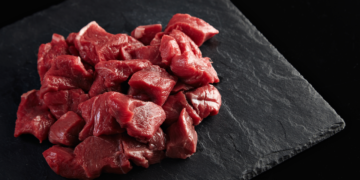When we first started cooking for RIley, we did some research and chose to follow a meal composition of 40% protein, 50% vegetables and 10% starch. We didn’t think about adding fat as we held on to the misconception that fat isn’t good for health.
After 4 months of nutrition studies ~ I can see the categorisation of ingredients into proteins, vegetables, starch and fat makes us see food groups in ways that are incomplete and flawed.
Why is strict categorisation flawed? These examples show that most ingredients are a mix of protein, fat, fibre or starch:
- example 1 : ground beef (grass fed) is perceived to be all protein. It is 19% protein and 13% fat.
- example 2 : broccoli is perceived to be all fibre. It is 89% water, 3% protein and 3% fibre.
- example 3: brown rice is perceived to be all starch. It is 73% starch, 7% protein, 3% fat and 3% fibre.
You can see that it is impossible to prepare a meal for Riley that is 40% protein, 50% vegetables and 10% starch.
Seeing food grouped into protein, vegetables, starch and fat also neglects the important role of vitamins and minerals in food.
What does the body need?
- the body’s first priority is getting energy from whatever protein, fat or carbohydrates is present in food consumed
- once basic energy needs are met ~ then nutrient needs get satisfied
How important are proteins? Haemoglobin is the protein inside red blood cells. Enzymes and antibodies are proteins.
- all proteins have a lifespan and are replaced
- red blood cells are replaced every 3 to 4 months
- some enzymes are replaced every few minutes
- fruits and vegetables high in insoluble fibre are added to help give stools better shape and texture (this fibre cannot be digested)
- root vegetables and fruits high in soluble fibre like pectin are added to boost the health of intestinal microorganisms (this fibre can be fermented in the gut)
- starch in food is digested to yield energy
- provides more than double the energy of protein and starch
- helps the body absorb vitamins A D E K
- supports hormone function and brain health
- omega-3 fats have anti-inflammatory effects
- support many critical functions in the body for healthy living
- D, E, calcium, iron, copper and zine are the vitamins and minerals that need more attention as they can sometimes be lacking in homemade diets
HERE IS HOW WE SEE FOOD
We plan our dogs’ diets to satisfy five key needs. This ensures they have a healthy gut, strong bones, shiny fur, bright eyes and are bursting with joy.
Foods often overlap and satisfy multiple key needs. Seeing food this way provides a more rounded perspective on the different contributions foods make towards well-being.
1. PROTEIN NEED
- a variety of meat, poultry, fish, seafood and eggs to provide protein needed to build cells, enzymes and antibodies
- this variety helps ensure adequate vitamins and minerals are present in meals
2. VEGETABLE NEED
- a good variety of vegetables helps ensure a broad range of vitamins, minerals and antioxidants are present in meals
- vegetables adds volume to the food which fill stomachs ~ this is helpful for weight loss or dogs with big appetites
- fibrous vegetables give stools better shape and structure
- root vegetables and fruits with pectin support the health of intestinal microorganisms
- grains and root vegetables add starch to diets which is another energy source
3. FAT NEED
- fat is an important source of energy, providing more than proteins and carbohydrates ~ the body’s preferred source of energy for very active and working dogs
- fish oils, yoghurt, milk, butter, ghee or coconut oil help absorption of vitamins A D E K
- makes food more appetising ~ this is helpful with picky eaters
- hormone balance, signalling molecules, cell structure, wound healing and other critical functions are disrupted without fat
4. VITAMIN & MINERAL NEEDS
- critical for long term health and well-being, vitamins and minerals often gets overlooked
- certain vitamins and minerals are usually lacking in homemade meals so we often choose ingredients based on how much A, D, E, calcium, iron, copper and zinc they can add
- for example, we choose fatty sea fish regularly as this provides a lot of vitamin D which is lacking in beef, pork and chicken
- another example is the addition of ground eggs shells to every meal to help bring calcium levels in meals up to minimum requirements
5. SUPPORT NEEDS
- the focus is ensure the presence of antioxidants, anti-inflammatories, anti-bacterials and other goodness as needed in diets
- for example, adding omega-3 fats like flaxseed oil to meals to help resolve inflammation and promote tissue repair
- or adding tumeric powder to diets for its anti-inflammatory, antiviral, antibacterial, antifungal and wound healing benefits
WHAT ELSE TO LOOK FOR
RECIPE PROFILE
- how much energy the recipe provides and roughly how much to feed an active or inactive, neutered or intact dog
- information about the % of protein, fat, carbohydrate and fibre in the recipe
- information about which vitamins or minerals may be lacking in the recipe that need attention in the next meal or topping up with supplements
PREPARATION, COOKING & STORAGE
- preparation, cooking, mixing and storage methods should help ensure high nutritional intactness of ingredients
- for example, pureed vegetables con’t provide the needed fibre structure for healthy stools
- overcooking can destroy some vitamin Bs
- the longer foods are frozen, the more significant the decrease in nutrient quality
WELLNESS INDICATORS
Check the following regularly:
- body weight and body condition score (between 4 -5)
- appetite & activity levels
- stool frequency + ease of passing motion
- stool quality ~ texture, odour and colour
- condition of hair, skin and paw pads
If You Enjoyed Our Content
please consider buying us a coffee / sending us dog treats



